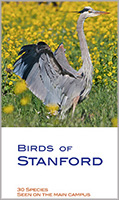Birds of Stanford
125 birds to look for on the main campus
Violet-green Swallow
one of numerous paintings by
Carel Brest van Kempen
2024
Wondering which birds might be increasing or decreasing at Stanford?
Check Harry Stevens' interactive article in the Washington Post (January 17). It's based
on data from eBird. You can also check the status of individual species across North America.
 2023
2023
Visit artist Todd McGrain’s large-scale bronze sculptures of five extinct bird species:
passenger pigeons, Labrador ducks, Carolina parakeets, great auks and heath hens,
which are part of his “Lost Birds” Project and will be on campus through February 2024.
For more information, see the Anderson Collection's coverage, which includes a larger map.

American kestrels are relatively common, but declining, with 2 million lost in North
America since the 1970s. Losses may be due to fewer insect and other prey, pesticides killing r
odent and insect prey and building up in kestrels, competition for nest cavities with invasive,
European starling, predation by Cooper's hawks, etc. See Spring 2023
article in Audubon.
This 8"x8" painting (acrylic on panel) is by local artist Floy Zittin.

Take a look at the Birds of Jasper Ridge Photo Gallery, a searchable data base of photos
by Peter and Diane Hart, who record JRBP's birds in their natural habitats.
2022
The Cornell Lab's BirdCast provides county bird migration information. Click to see the
number of birds flying through Santa Clara County (CA)
2018
GPs in Shetland (UK) can now prescribe "nature" for patients
2017
Study indicates watching birds near home is good for mental health
died of COVID-19 in 2020. (See this retrospective by Gretchen Daily and Paul Ehrlich in Science.)
He noted in his INTRODUCTION to The Birds of Stanford website: "Stanford's academic reserve is
home to many things, some of them icons for the university's identity: laboratory buildings, splendid
outdoor sculpture, the Quad, Frost, Hoover Tower, and the Oval. It has also left room for Nature. The
Arboretum, the edges of Lagunita, and the "ears" of the Oval--left in native vegetation in Frederick Law
Olmsted's original plan--provide pleasant places to walk and explore. ... more
125 SPECIES ACCOUNTS
Primarily from The Birder's Handbook,
covering aspects of breeding, dislays,
nest, eggs, diet, and campus locations
Alphabetical Order
Taxonomic Order
150 ESSAYS
Primarily from The Birder's
Handbook
covering
aspects of bird natural history
GALLERIES
Featured artists as well as fine art, illustrations and photography
submitted by site visitors
Submit art
CAMPUS WALKS
Arboretum, Arizona Garden, Memorial
Marsh, Dish Area, Lake Lagunita
Submit bird sightings
Campus Species Check List


